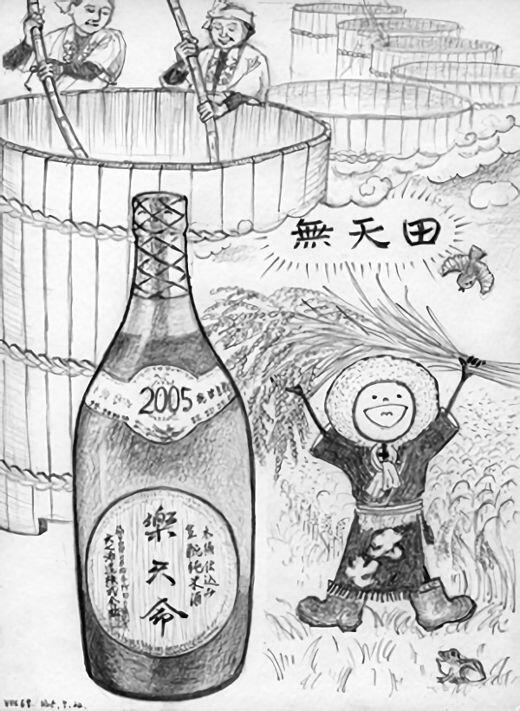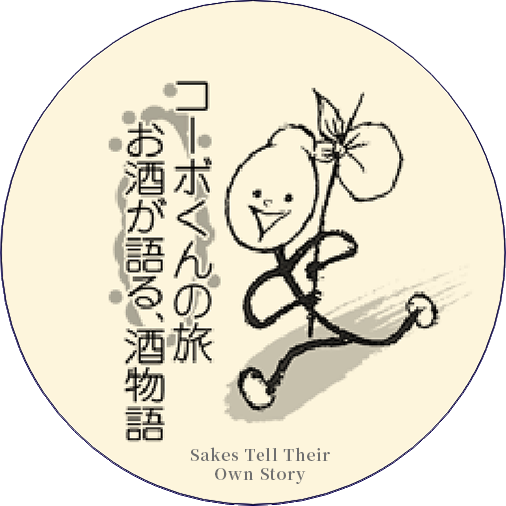| Yeast |
“Today I’m going to listen to the story of Rakutenmei, the highest peak among the junmai sakes of Daishichi. I’m a bit nervous… |
| Rakutenmei |
“Welcome, Yeast. How are you?” |
| Yeast |
“Aren’t you a sake brewed in a wooden vat, a technique revived after fifty years?” |
| Rakutenmei |
“Indeed. I have to express my thanks to the American Sarah Cummings, who first proposed the revival. Actually, at first I was not so much interested.” |
| Yeast |
“How come?” |
|
 |
| Rakutenmei |
“Traditional culture is important, but I was not sure that the use of wooden vats would be more than just a trendy topic. I changed my mind when I visited a certain winery, the world’s most famous Bourgogne domain. There I saw wonderful old wooden vats which were still in active use. At that moment I felt I would like to try it as well.” |
| Yeast |
“How dramatic!” |
| Rakutenmei |
“The choice of wooden vats by today’s best winery meant that there must be a good reason for using wooden vats. I definitely wanted to try that out with Daishichi’s kimoto method.” |
| Yeast |
“And with what result??” |
| Rakutenmei |
“Brewing with wooden vats has unique class, great depth, and a concentrated flavor. On top of that it is powerful. My eyes were opened.” |
| Yeast |
“Why was that?” |
| Rakutenmei |
“In the past, the fermentation of sake used to be a very complex process. Modern technology has simplified that by doing away with elements that were not properly understood. As a result, some difficult to define deep flavors were lost. But these can be revived by brewing in wooden vats, just as by using the kimoto method.” |
| Yeast |
“You’re right! That is why Daishichi had to become involved!” |
| Rakutenmei |
“I agree. When we look at history, wooden vats were first used in Japan in the Muromachi period (1336-1573), enabling brewers to produce much more sake than with the earthenware jars that were used previously, so that a real sake market was born. Through the influence of that market, sake was further refined, and developed from a native drink into a world beverage. It is interesting to realize that the use of wooden vats was the first stage in that process. At the start of the 21st century, in 2001, Daishichi has therefore revived brewing in wooden vats, and we have just discussed to what results that has led.” |
| Yeast |
“Sales started in 2003, didn’t they?” |
| Rakutenmei |
“Yes, because that much time was needed to make my hidden properties blossom by maturation. In fact, also after that I needed several more years to fully mature.” |
| Yeast |
“The brewers were first a half year long busy repairing the wooden vats, and then they brewed you with organic Gohyakumangoku rice they had cultivated themselves. They really gave you a lot of attention!” |
| Rakutenmei |
“I’m grateful for that. Do you want to hear about the origin of my name? ‘To take delight (raku) in the Mandate of Heaven (tenmei)…’ Doesn’t that mean that we should perfect ourselves while taking delight in what we do?” |
| Yeast |
“Yes! We also should try hard! I shall never forget the impressed silence that followed when we had drunk Rakutenmei at a certain party. The guests were very enthusiastic, although you are not a daiginjo.” |
| Rakutenmei |
“Not all top sake has to be daiginjo, there are also other ways.” |
| Yeast |
“Finally tell me about how to enjoy you and what foods fit to you.” |
| Rakutenmei |
“I definitely want you to drink me as nurukan (slightly warmed to about 40 C.). Foods with a rich umami will fit perfectly. In the case of Western food, also wild game meat and cheese.” |
| Yeast |
“Thank you very much!” |





